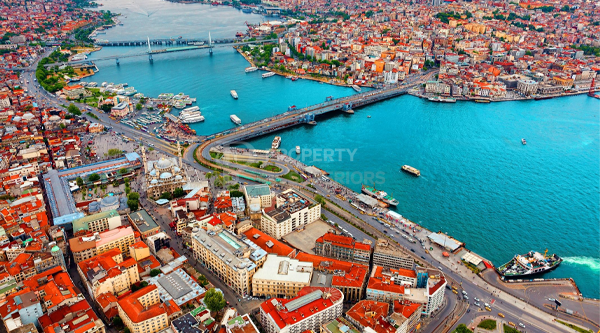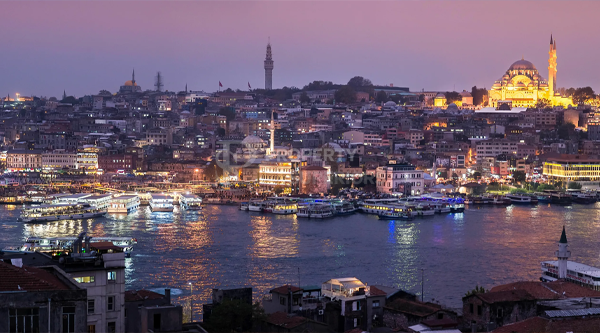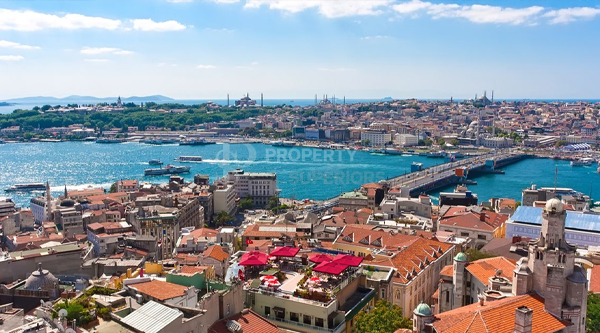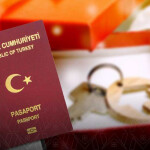
The Bosphorus often eclipses Istanbul's Golden Horn. However, the mouth of the Golden Horn is just as important to the city, which has a vast historical timeline spanning the Byzantine Empire, the Ottoman era and today's Turkish Republic. Anyone who knows its history speaks of the Golden Horn during the famous siege of Constantinople. Sitting on the European side of Istanbul, Mehmet brought the conquerors across the Golden Horn and began the famous Ottoman rule of what was then Constantinople. But today, the stakes are far greater on both sides of the Golden Horn. A stroll around the sights is a wonderful introduction to this famous city.
1: Why is it called the Golden Horn?
The answer to why it's called the Golden Horn has two parts. First, the gold color is to reflect the color of the setting sun when it hits the water. Secondly, the canal at the exit of the Bosphorus Strait is trumpet-shaped and deeply curved, so it is called the Golden Horn. However, some historians say the gold aspect refers to its importance throughout history as an important trading port, and therefore wealth. An interesting fact about the Golden Horn is that the maximum depth is usually 35 meters.
2: Why is the Golden Horn important?
The Golden Horn opens directly onto the European side of Istanbul, effectively dividing that part of the city into two banks. During the Byzantine era, the palace was not far from the Golden Horn. Additionally, Cape Horn was an excellent trade route, so security was tight against attack by sea. Ships from all over the world moored here, and merchants from Genoa and Italy once established bases here. The Byzantine Empire built walls to protect the land; however, they were not enough. As a second security measure, they placed a chain across the entrance to the Golden Horn to prevent invading armies from crossing the sea.

3: The famous Golden Horn chain
The chain of the Golden Horn stretches 500 meters from the Galata district at the entrance to the Topkapi compound on the other side. Chains stop unwanted boats from entering. But this is where Mehmet, the conqueror of the Ottoman Empire, got creative. When he attempted to invade Constantinople, he knew that attacking from the less walled shores of the Golden Horn would be a major victory for him.
Although he couldn't break the huge iron chain, he still walked around her. At the time, much of Beyoglu was woodland. So he ordered his men to cut down the trees, shape them into logs of equal size and length, and coat them with oil. Then he pulled all his ships out of the waters of the Bosphorus and carried them overland by brute force on those logs to the Golden Horn on the other side of the chain.
The Byzantines were outwitted, a move that led to their downfall. While this was not the first Muslim siege, the move ensured that the conquest was the only one to succeed. Ottoman rule in Constantinople begins. Today, part of the chain is in the Military and Archaeological Museum in Istanbul. The last time warships were seen in the Golden Horn was after the First World War, when the Ottoman Empire was on the losing side and Allied naval vessels turned inward.
4: The famous Galata Bridge
Four bridges separate the north bank from the opposite bank, but the most famous is the Galata Bridge. The bridge connects the Eminonu neighborhood of Fatih district with the Karakoy neighborhood of Beyoglu. In 1502 da Vinci designed a bridge. However, Sudan never approved the design. In 1845, the first Galata Bridge was built. Of course, wood doesn't last long, and the bridge has been rebuilt five times over the years.
The last and current version took place in 1994. But in 2003, a restaurant was added to the walkway under the bridge. Today the Galata Bridge is an iconic landmark of Istanbul. Most people will recognize the fishing bridges on either side. In addition, small ferries carry passengers for commuting or leisure cruises in the Golden Horn and the Bosphorus.
5: Northern Shore of the Golden Horn
The most famous part of the north coast is Beyoglu, which also lines up with the Bosphorus. The area is home to the famous Galata Tower which offers a great view of the whole of Istanbul. Further inland is Istiklal Avenue in the Taksim district, Istanbul's new shopping and nightlife district and hub.
Throughout history, many non-Muslims have lived on this side of the Golden Horn and thus have a solid Jewish background. This trend continues to this day with many expats buying properties in areas such as Cihangir. Places like Bank Street in Karakoy have wonderful architecture. Also, at the northeast end is Miniaturk, a miniature park where you can explore all of Turkey's famous sights in one day. Beyoglu is known for the Istanbul Museum of Contemporary Art, a cultural and exhibition center for emerging artists.
- Galata Tower: From the tower you can overlook the Golden Horn, an important part of Istanbul. However, over time the magnificent structure suffered several fires and in 1348 the Genoese rebuilt their version of the Tower of Jesus. A hundred and fifty years later, the Ottoman Empire ruled Constantinople.
- More about Beyoglu: For those who want to know more about this part of Istanbul, this Beyoglu guide talks more about the landmarks, history and places to visit. While at first glance many people think Beyoğlu is all about modern shops and bars, behind the scenes there are charming signs of old Istanbul.
6: Golden Horn Southern Shore
On the other side, at the entrance of the Golden Horn, is the famous Fatih district, known as Old Istanbul. The Eminonu neighborhood is on the Golden Horn. Although the neighborhood extends inward, it is adjacent to the Bosporus Strait and partly extends to the Sea of Marmara. Fatih is also home to the famous Sultan Ahmet district, which was ruled by the Byzantine and Ottoman empires and known as the Old City. Notable landmarks here are the Blue Mosque, Hagia Sophia, and Topkapi Palace. The famous Egyptian Spice Bazaar and Grand Bazaar are just a short walk from the Golden Horn hotel.
Sultanahmet Attractions Guide: Ah, the sights of Sultanahmet put this vibrant Istanbul district on the world stage. But of course, Sultanahmet itself is not an official region. Just one block. Despite this, Sultanahmet attracts thousands of tourists every day, eager to see the attractions that make Istanbul the most popular tourist destination in Turkey.

7: Also Visit Balat and Fener
For decades, the two aforementioned regions dominated Istanbul's tourism industry. But with the advent of the internet and self-guided travel, more and more people want to explore the neighborhood. Both Bharat and Fennel became famous. Fenell is located on the west coast of the Golden Horn. It used to be a Greek settlement, while Balata was a Jewish settlement. While both are now working-class suburbs, they've experienced a renaissance as people flock to admire the old architecture and style of homes. Walk through the old streets with clothes racks and children playing football, and this is Authentic Istanbul. Novice and seasoned street photographers alike are looking for original photo subjects that catch the eye at every turn, while professionally guided walking tours tend to sell out.
8: Where to See the Best Views of the Golden Horn
So it is very interesting to explore places on both sides of the Golden Horn on foot. But what if you get a breathtaking view from the top of the mountain? For that, head to Pierre Lotti Café. Located in the Eyup district, this open-air cafe has a spectacular natural setting within the urban landscape.
Although this is not a complete aerial view of the Golden Horn, it better showcases the beauty of the Golden Horn. While there, explore the Eyup Mosque and the larger area steeped in Islamic history. During the Ottoman era, Eyup was home to many factories that produced Fes, the famous Ottoman red hat that was banned by the new Turkish Republic. More information about Eyüp district.
About Istanbul
Bosphorus Villages Worth Exploring: Istanbul's Bosphorus villages aren't as well-known as Old Sultanahmet or Beyoglu and Taksim. Nonetheless, they are equally important to Istanbul. Most people know that Istanbul is divided into two continents, Asia and Europe, by the Bosphorus. But the waters are so much more than that, an important maritime trade route between Asia, Europe and Russia.
Yali Mansions on the Bosphorus: From the Golden Horn to the famous Bosphorus, we enter Turkey's most expensive real estate market. These beach houses show Istanbul's past and present, and if you take a ferry from Istanbul's Golden Horn, you'll see them for yourself.
Related posts:
The goal of many people who want to own real estate in Turkey is to obtain an ideal apartment in Turkey within the city of Istanbul or any other Turkish city, and buyers focus on several factors that they want...
Buying a property in Turkey is not a difficult or complicated process or requires bureaucratic procedures. Rather, it is done through simple steps that lead to the new owner obtaining the Tabu document, which shows that he has the legal...




 New provisions for obtaining Turkish citizenship through real estate ownership
New provisions for obtaining Turkish citizenship through real estate ownership
 Turkish Real Estate Rental Law 2024
Turkish Real Estate Rental Law 2024
 Ways to obtain Turkish citizenship through investment 2024
Ways to obtain Turkish citizenship through investment 2024
 How to choose an ideal apartment in Turkiye?
How to choose an ideal apartment in Turkiye?
 Turkish passport... Extraction method and fees 2024
Turkish passport... Extraction method and fees 2024
